Greece › Crete Travel Guide
Updated: January 7, 2026 • By Santorini Dave
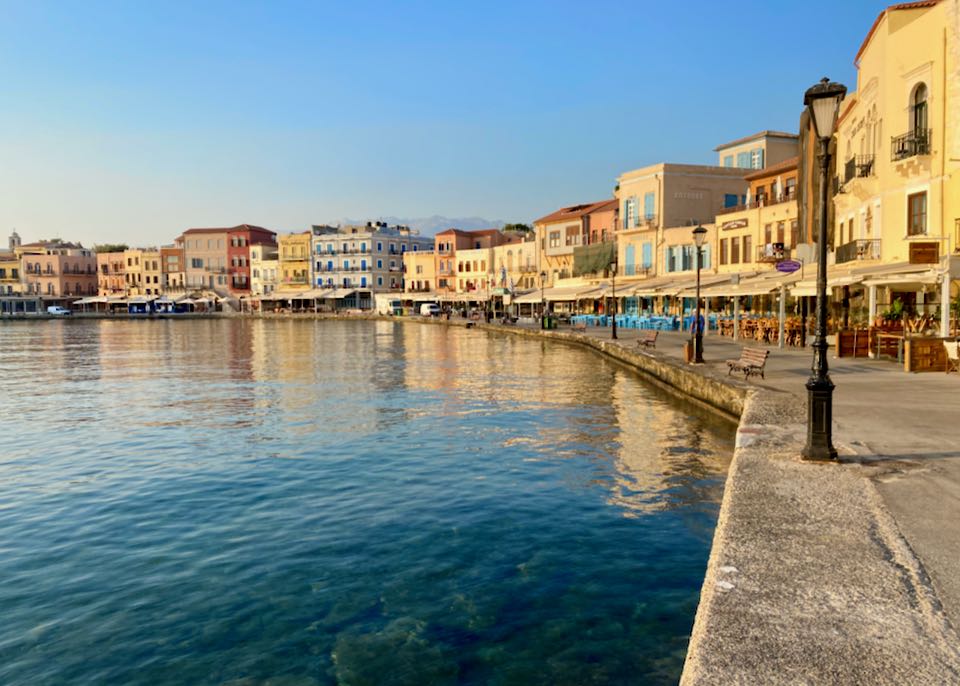
The harbor in Old Town Chania is filled with cafes and restaurants and backed by a charming warren of crisscrossing lanes and alleys.
Crete is the largest island in Greece and a land of stunning contradictions. It feels less like an island and more like a small country, where snow-capped mountains rise above turquoise lagoons and ancient Minoan palaces sit just minutes from bustling modern cities. Distinct from the tiny, dry Cyclades like Santorini and Mykonos, Crete is lush, rugged, and vast. It deserves a week to even scratch the surface; attempting to see it all in a few days is a recipe for exhaustion. Whether you want to hike Europe’s longest gorge, float in pink-sand waters, or eat the world’s healthiest food in a mountain village, Crete offers a depth of experience that smaller islands cannot match.
The highlight for most is the Venetian harbor town of Chania in the west, filled with boutique hotels and incredible dining. However, Rethymno (central), Heraklio (the capital), and the luxury enclaves of Elounda and Agios Nikolaos in the east all make excellent bases depending on your style. Must-dos include the legendary Palace of Knossos, the rugged Samaria Gorge hike, and the pink sands of Elafonisi. While the bus system is reliable for city-hopping, renting a car (most easily from Heraklion Airport) is essential to reach the best hidden beaches and mountain villages.
My 2026 Crete Travel Guide
- Skip to our Crete FAQ
Crete Basics
Crete Hotels
- Best Hotels in Crete
- Best Hotels in Crete for Families
- Best Hotels in Chania
- Best Hotels in Rethymno
- Best Hotels in Heraklio
- Best Hotels in Elounda
Crete Activities and Attractions
Crete Travel Planning
- Athens to Crete Ferry
- Crete to Athens Ferry
- Santorini to Crete Ferry
- Crete to Santorini Ferry
- Heraklio Ferry Port Guide
- Heraklion Airport Car Rental
- Crete Bus Routes & Schedules
Latest Articles & My Travel Newsletter
Frequently Asked Questions about Crete
See Also: Greece: Tips & Information for First-Timers
Where is Crete?
Crete is the largest island in Greece and the fifth largest in the Mediterranean (after Sicily, Sardinia, Cyprus, and Corsica). It sits far south in the Aegean Sea, approximately 160 km (100 miles) south of the Greek mainland and 300 km (190 miles) north of Africa.
- Size & Scale: It is massive. The island is about 260 km (160 miles) long from west to east. It takes at least 4 to 5 hours to drive across the island, so do not expect to see it all in a few days.
- Population: Home to approximately 625,000 permanent residents, it is a fully functioning society year-round, not just a summer tourist destination.
- Climate: Its southerly location gives it one of the warmest and sunniest climates in Europe, with a swimming season that stretches comfortably from May into late October.
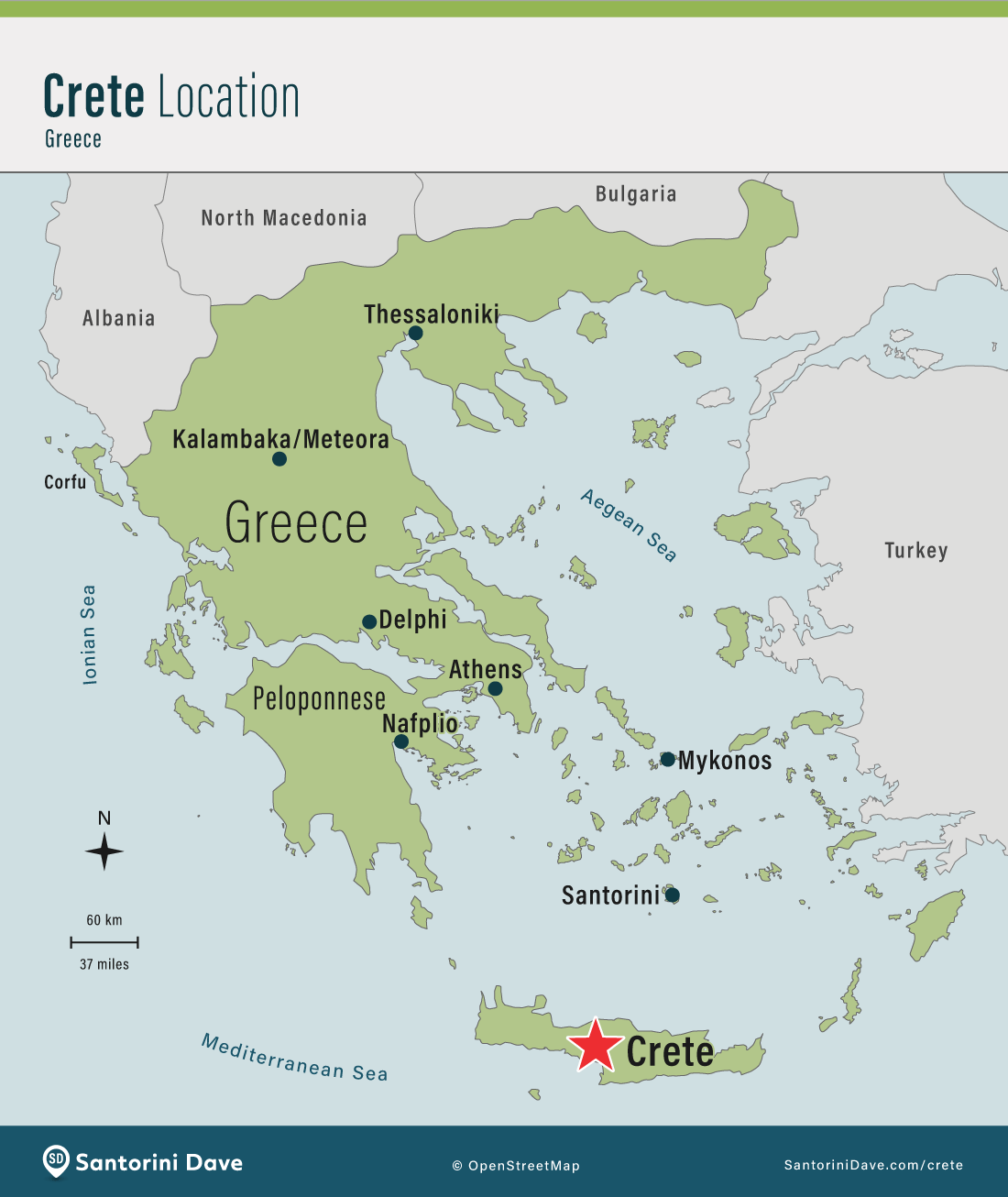
How do I get to Crete? (Flights & Ferries)
You can arrive by plane or ferry. Because Crete is so far south, flying is usually the best option unless you are island-hopping from Santorini.
By Plane (The Easiest Way)
Crete has two main international airports. Choose the one closest to where you are staying to avoid a long drive upon arrival.
- Heraklion (HER): The largest airport, centrally located. Best if staying in Heraklio, Elounda, Agios Nikolaos, or Malia.
- Chania (CHQ): Located in the west. Best if staying in Chania, Rethymno, or the south coast.
- Sitia (JSH): A tiny airport in the far east, serving mostly domestic flights.
Flight Tips
- From the US, Canada & Australia: There are no direct flights to Crete. You must connect through Athens (45-minute flight to Crete) or a major European hub like London, Frankfurt, or Munich.
- From Europe: From April to October, there are hundreds of direct charter and commercial flights from almost every major European city.
- From Athens: Aegean and Sky Express fly multiple times daily year-round. Book early to get fares under €60.
Should I fly into Chania or Heraklion?
Crete is massive (260km long). Picking the wrong airport can mean a 3-hour drive to your hotel.
- Fly into Chania if: You are staying in West Crete. This is the best airport for visiting Chania Old Town, the famous beaches (Elafonisi, Balos, Falassarna), and hiking the Samaria Gorge.
- Fly into Heraklion if: You are staying in Central or East Crete. This is the best hub for visiting the Palace of Knossos, the Archaeological Museum, Hersonissos, Malia, Agios Nikolaos, or the luxury resorts of Elounda.
- The Pro Tip: Book an “Open-Jaw” ticket. Fly into Chania, rent a one-way car, drive across the island over a week or two, drop the car at Heraklion, and fly out of Heraklion. This saves you hours of backtracking. Or continue on to Santorini and fly out of there.
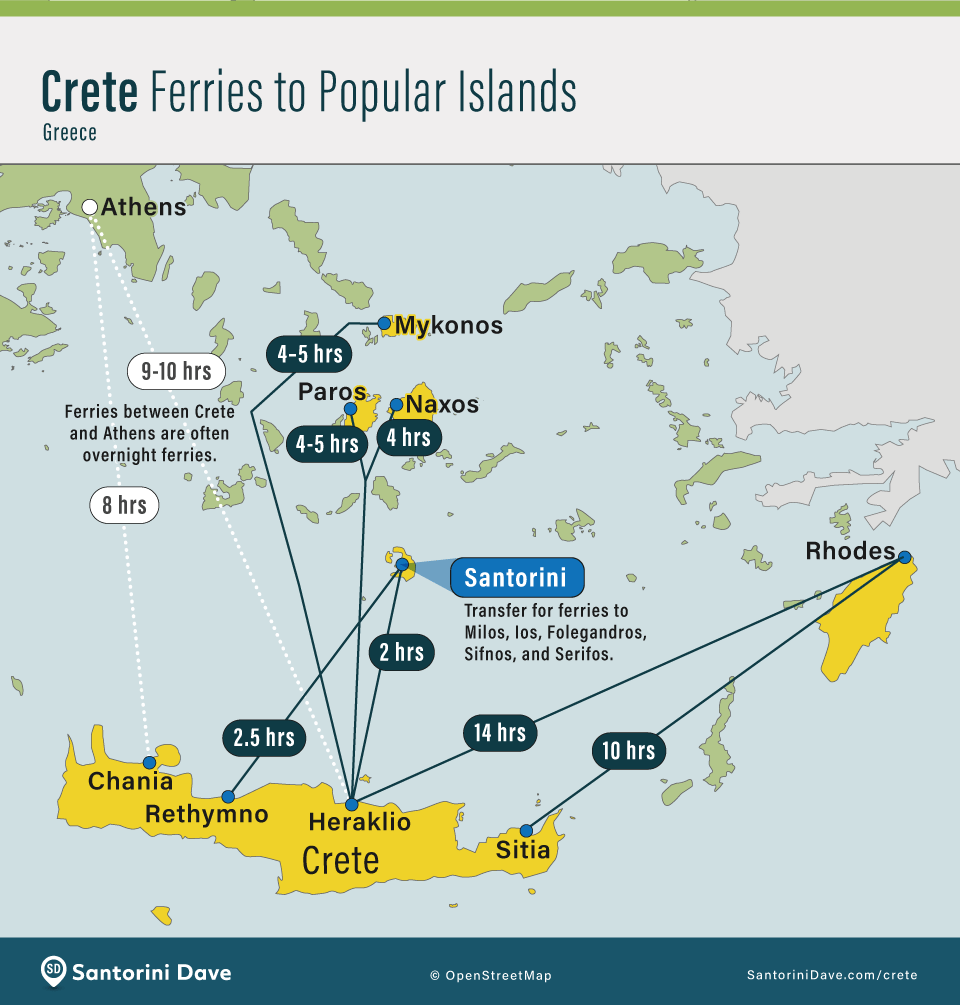
By Ferry (The Scenic Way)
Ferry connections are excellent in summer but serve two very different purposes.
- From Athens (Piraeus): This is a long haul. Ferries run daily year-round. Most travelers prefer the overnight ferries (like ANEK/Blue Star), which depart Athens around 9:00 PM and arrive in Crete at 6:00 AM. Booking a cabin allows you to sleep and save on a night’s hotel. High-speed daytime ferries exist in summer (about 6 hours) but are tiring.
- From Santorini: This is the most popular island-hop route. From April to October, high-speed ferries (SeaJets/Minoan) run daily. The trip takes just 2 hours to Heraklio.
- From Other Islands: In high season, there are connections to Mykonos, Paros, Naxos, Ios, and Milos, usually via the high-speed SeaJets route that terminates in Heraklio.
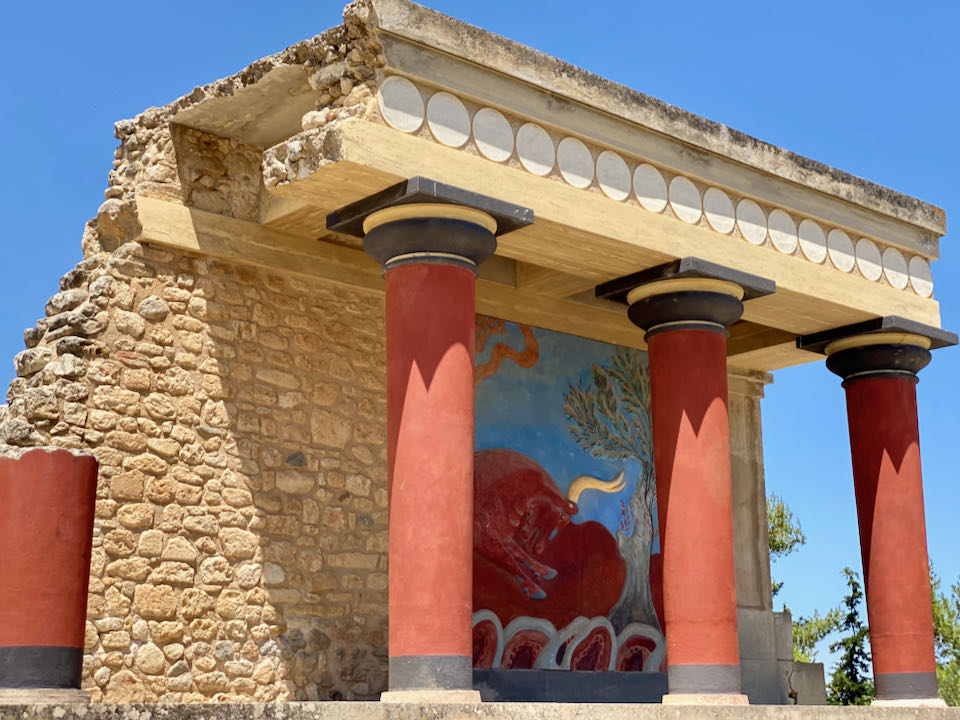
The ancient Minoan palace at Knossos, one of the most important archaeological sites in Greece.
What is the best time to visit Crete?
Crete is the best year-round destination in the Greek islands, but the “best” time depends entirely on what you want to do.
The Sweet Spot: May, June, September, & October
These are the best months. You get sunny weather, lower prices, and fewer crowds than in peak summer.
- For Swimmers (September/October): If your priority is the beach, go in late September or early October. The sea has been heating up all summer and is like bathwater. In May, the weather is nice, but the sea can still be brisk (19°C/66°F).
- For Hikers (April/May): Spring is incredible. The island is green and covered in wildflowers, and the gorges (like Samaria) usually open in May. It is not yet too hot for long treks.
Peak Summer: July & August
- The Vibe: Hot, crowded, and expensive. Temperatures can hit 35°C (95°F). This is the best time for nightlife in Hersonissos or Malia, but visiting archaeological sites like Knossos requires an early morning start to avoid heat exhaustion.
- Wind: The northern meltemi winds provide relief from the heat but can make north-coast beaches wavy.
Winter: November to March
Unlike Santorini or Mykonos, which largely shut down, Crete remains vibrant.
- What to expect: The beach resorts close, but the main cities (Heraklion, Chania, Rethymno) are real working cities with students and locals. The restaurants, museums, and shops stay open. It is the best time to see the real Crete without tourists, though it will be too cold for swimming and rain is possible.
Can I swim in Crete in May or October?
Yes, absolutely, but the experience is very different in spring versus autumn. Because Crete is so far south (it is closer to Africa than Athens), it has the longest swimming season in Greece.
- May (The “Refreshing” Swim): The weather is beautiful (sunny, green landscape), but the sea is still warming up from winter. Water temperature is around 19°C (66°F). It is brisk. Most people can do a quick dip, but you probably won’t stay in for an hour unless the sun is blazing.
- October (The “Warm” Swim): The air temperature cools down (making sleeping easier), but the sea retains the heat from the long summer. Water temperature is around 23°C (73°F) – significantly warmer than in May. It is perfect for long, lazy swims.
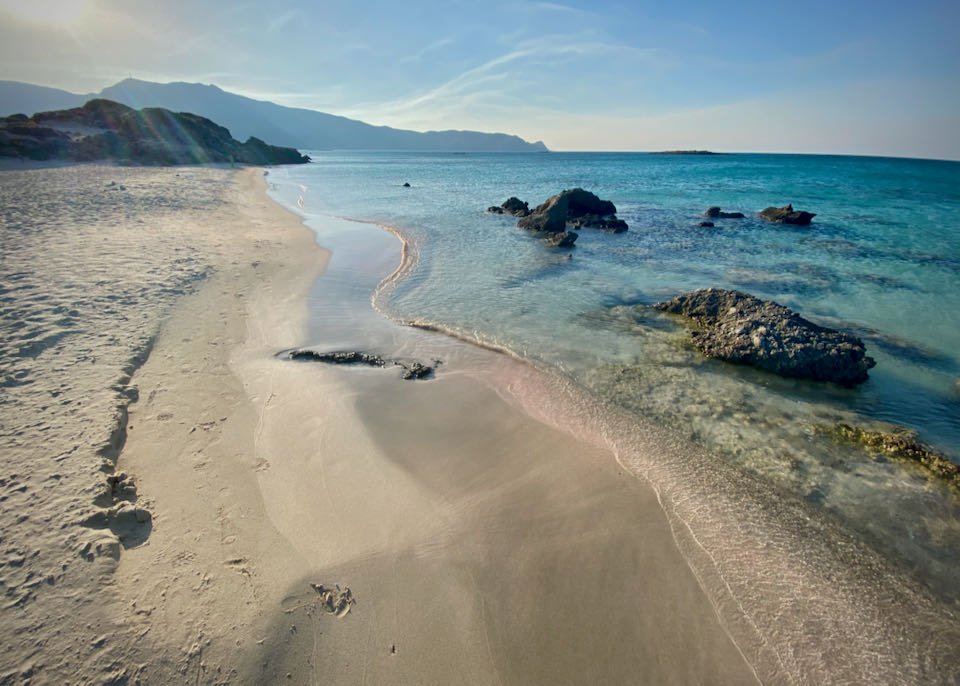
The unique pink-hued sand of Elafonisi Beach gets its color from the crushed up pink shells of tiny sea creatures. Elafonisi is consistently rated one of the world’s top 10 beaches.
How many days do I need in Crete?
Crete is not just an island; it is practically a country. It is 260km long, and driving from end to end takes 5 hours. To see it properly, you need time.
The Golden Rule: Plan for 7 Days (Minimum)
A week allows you to explore ONE side of the island (West or East) thoroughly without spending your entire vacation in a car.
- West Crete (Chania/Rethymno): The most popular region. 7 days allows you to explore Chania’s Venetian harbor, hike the Samaria Gorge, and visit the world-famous beaches of Elafonisi and Balos.
- East Crete (Heraklion/Elounda): 7 days gives you time for the Palace of Knossos, the Heraklion Archaeological Museum, the luxury resorts of Elounda, and the island of Spinalonga.
10 to 14 Days: The Ideal Trip
With 10+ days, you can see the “Best of Both Worlds” by splitting your stay.
- The Strategy: Spend 5 nights in the West (based in Chania) and 5 nights in the East (based in Heraklion or Elounda). This saves you hours of backtracking.
- What you get: You can see the pink sand beaches of the west AND the Minoan history of the east without rushing.
4 Days or Less: The “City Break”
If you have limited time, do not try to see everything. Pick ONE base (Chania is best for atmosphere) and stick to it.
- Day 1: Explore Chania Old Town.
- Day 2: Beach day (Elafonisi or Falassarna).
- Day 3: Boat trip to Balos Lagoon.
- Day 4: Departure.
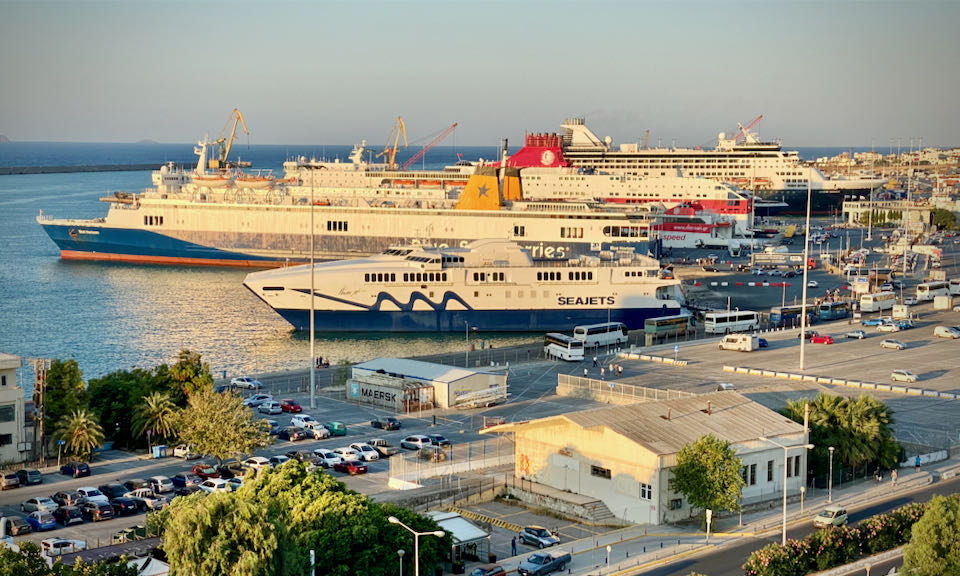
Heraklion Ferry Port is the busiest on Crete, serving regular routes to and from Athens, Santorini, and other nearby islands.
What are the best towns and cities to visit?
Crete’s towns are incredibly diverse. Most visitors stick to the north coast, but the real magic often lies in the remote south or the mountain villages.
The Big Three (North Coast)
These are the main hubs. They are connected by the main highway and have excellent bus links.
- Chania (The Most Beautiful): If you only visit one town, make it Chania. Its Venetian Harbor and Egyptian Lighthouse are iconic. Behind the waterfront lies a stunning, car-free maze of alleyways filled with bougainvillea, boutique hotels, and incredible dining. It is the best base for the famous west coast beaches (Elafonisi/Balos).
- Rethymno (The Best All-Rounder): Located between Chania and Heraklion, Rethymno has a similar “Venetian Old Town” charm to Chania but feels slightly more laid-back. It has a massive fortress (Fortezza) and, crucially, a long sandy beach right in the city center, which Chania lacks.
- Heraklio (The Capital): It is a gritty, bustling working city, not a postcard village. However, it is essential for history buffs. Stay here for 1 or 2 nights to see the Palace of Knossos and the world-class Archaeological Museum. It also has a fantastic pedestrian shopping center and great food scene.
The East (Luxury & Views)
- Agios Nikolaos: A picturesque town built around a “bottomless” lake connected to the sea. It has a chic, vibrant vibe with great cafes and is less chaotic than the big western cities.
- Elounda: The most exclusive enclave in Greece. This is where you find the ultra-luxury resorts with private peninsulas and helipads. It is the gateway to the historic leper colony island of Spinalonga.
The South (Remote & Wild)
- Loutro: A tiny, whitewashed village accessible only by boat or foot. There are no cars. It is peaceful, stunningly beautiful, and perfect for doing absolutely nothing but swimming and eating fresh fish.
- Chora Sfakion (Sfakia): The rugged capital of the south. It is a transport hub (ferries to Loutro/Gavdos) but has an authentic, fiercely independent spirit and excellent food (try the Sfakian pie).
The Traditional Villages
- Archanes: Located in the wine country south of Heraklion. It has been voted one of the best-restored villages in Europe. It is colorful, alive, and surrounded by vineyards. A fantastic lunch spot.
- Margarites: A beautiful village near Rethymno famous for its pottery tradition. You can visit dozens of ceramic workshops and watch artisans working on wheels using Minoan techniques.
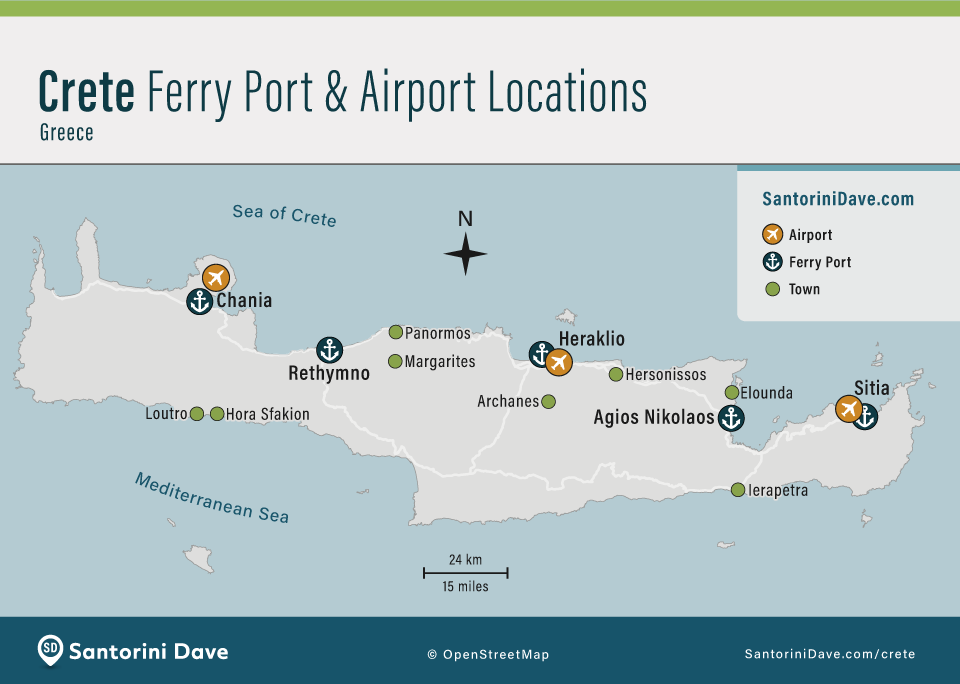
How expensive is Crete compared to Santorini or Mykonos?
Crete is significantly cheaper and offers much better value for money. Unlike Mykonos and Santorini, which are purely tourist economies, Crete is a fully functioning agricultural island.
- Accommodation: You get far more for your Euro. A luxury boutique suite in Chania might cost €200/night, whereas a similar standard in Oia (Santorini) would cost €600+.
- Food: Dining is cheaper and the portions are huge. In mountain villages, you can have a feast with wine for €20-€30 per person.
- The Hidden Cost: A larger expense in Crete is transportation. You really need to rent a car to see the island properly, and fuel costs add up given the distances.
Do I need to rent a car in Crete?
The short answer is: Yes, for the best experience.
While you can get around without one, Crete is massive (260km long) and its best secrets – the pink sand beaches, the mountain villages, and the south coast gorges – are difficult or impossible to reach by bus.
The Case for Renting a Car
- Freedom: The public bus (KTEL) is excellent for moving between main cities (e.g., Chania to Heraklion), but it is limiting for day trips. A car allows you to beat the tour buses to places like Elafonisi (arrive by 9:00 AM) or stay late for sunset at Balos.
- The South Coast: The southern side of Crete is wild and beautiful. Places like Matala, Preveli Palm Beach, and the Amari Valley are best explored with your own wheels.
- Driving Conditions: The main highway (VOAK) along the north coast is generally good, though it can be narrow. Mountain roads are winding but paved and scenic. Cretan drivers can be aggressive; the local custom on single-lane highways is to drive on the paved shoulder to let faster cars pass you.
The Case for NOT Renting (Using Buses & Tours)
- If you stay in a main city: If you base yourself in Chania or Heraklio and just want to see the main highlights (Knossos, Old Town, one beach), you can easily manage with the bus and organized day tours.
- Parking: Parking in Chania and Heraklio is a nightmare. If you rent a car, ensure your hotel has a dedicated spot, or be prepared to park in a municipal lot on the outskirts.
My Recommendation: Rent a car for at least 3 or 4 days of your trip. Use it to do a “road trip” loop to the south coast and the mountains, then return it and enjoy the cities on foot.
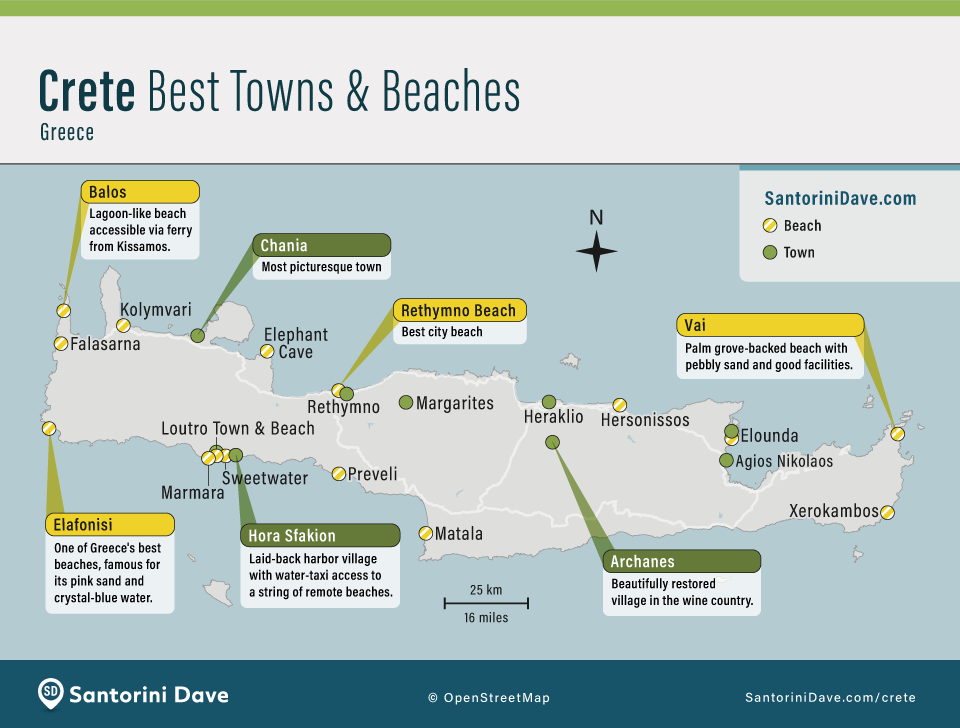
What are the best beaches in Crete?
Crete has over 1,000 kilometers of coastline. The beaches range from Caribbean-style lagoons to rugged, palm-lined river deltas.
The “Big Three” (The Famous West Coast)
These are the postcard beaches. They are spectacular but get incredibly crowded.
- Elafonisi (Southwest): Famous for its pink sand and shallow, turquoise lagoon waters. It is family-friendly and stunning. My favorite beach in Europe. Tip: It gets packed by 11:00 AM. Arrive by 9:00 AM or, better yet, stay in a nearby hotel to enjoy the sunset when the tour buses leave.
- Balos Lagoon (Northwest): A wild, exotic lagoon with white sand and vivid blue water. Access: You can take a day cruise from Kissamos port (easiest) or drive a rough dirt road and hike down 20 minutes (best for views, but strenuous).
- Falassarna (West): A massive, wide stretch of golden sand with crystal clear water. It is easier to access than Balos or Elafonisi (drive right up). Warning: It faces west, so it has amazing sunsets but can get very wavy when the wind blows.
The South Coast Gems (Wild & Unique)
- Preveli Palm Beach: A river flows through a palm forest into the sea. It feels like an African oasis. You must hike down a steep path (20 mins) to reach it.
- Matala: Famous for its hippie history and the caves carved into the sandstone cliffs overlooking the beach. Great for swimming and atmosphere.
- Sweetwater (Glyka Nera): A pristine pebble beach accessible only by boat or hike from Loutro/Sfakia. Famous for the fresh water springs that bubble up through the pebbles.
The East & North (Family & Resort)
- Vai (Northeast): Europe’s largest natural palm forest beach. It is organized, beautiful, and very popular in the east.
- Agios Nikolaos/Elounda: These are not massive sandy stretches but lovely, calm coves with crystal clear water, perfect for relaxed swimming near luxury hotels.
- Rethymno Town Beach: A huge, 12km stretch of sand starting right in the city. It is touristy and lined with hotels, but incredibly convenient if you want a beach holiday with city amenities.
What are the best historical sites and things to do?
Crete offers a mix of ancient mythology, Venetian history, and incredible outdoor adventures.
Top Historical Sites
- The Palace of Knossos (Heraklion): The absolute must-see. This is the center of the Minoan civilization and the legendary home of the Minotaur and the Labyrinth. Tip: It gets crowded. Go at 8:00 AM or after 5:00 PM. Combine it with the Heraklion Archaeological Museum, where the actual frescoes and artifacts are kept.
- Spinalonga Island (Elounda): A hauntingly beautiful Venetian fortress turned leper colony (active until 1957). It was made famous by Victoria Hislop’s novel The Island. Take a small boat from Plaka or Elounda to explore the abandoned streets.
- Arkadi Monastery (Rethymno): The most historic monastery on the island and a symbol of Cretan resistance. The story of the 1866 siege is tragic and moving. The architecture is stunning.
- The Venetian Harbors (Chania & Rethymno): You don’t need a ticket for these. Walking the seawall to the Egyptian Lighthouse in Chania or exploring the Fortezza in Rethymno offers a deep dive into the island’s Venetian and Ottoman past.
- Ancient Phaistos (South Coast): If Knossos feels too “reconstructed” and busy for you, visit Phaistos. It is raw, authentic, and offers incredible views over the Messara Plain.
Top Activities & Experiences
- Hike the Samaria Gorge: The longest gorge in Europe (16km). It is a challenging but rewarding all-day hike starting in the White Mountains and ending at the Libyan Sea (Agia Roumeli). Note: Open roughly May to October only.
- Cretan Cooking Class: Cretan diet is world-famous. Taking a class (often held at local olive farms) to learn how to make kalitsounia (cheese pies) and stuffed vegetables is a highlight.
- Boat Trip to Balos: If you don’t want to drive the rough road, take the daily cruise from Kissamos port. It stops at Gramvousa island (pirate fortress) and the lagoon.
- Visit a Winery: Crete produces excellent wines (Vidiano, Kotsifali). The region around Archanes and Peza (south of Heraklion) is the Napa Valley of Crete.
- Botanical Park & Gardens of Crete (Chania): A fantastic, lush garden created from the ashes of a wildfire. It showcases the island’s incredible fruit and flora. The onsite restaurant is one of the best farm-to-table spots in the region.
What are the best boat trips in Crete?
- Balos Lagoon & Gramvousa (West): The #1 boat trip on the island. Departing from Kissamos port, it takes you to the old pirate fortress of Gramvousa and the stunning shallow turquoise waters of Balos.
- Spinalonga (East): A short, frequent boat ride from Plaka or Elounda takes you to this hauntingly beautiful former leper colony and Venetian fortress. A must-do for history lovers.
- Loutro & Sweetwater Beach (South): Taking the “Daskalogiannis” ferry or water taxis along the south coast from Sfakia is magical. The water here is crystal clear and deep blue.
- Chrissi Island (South East): Located off Ierapetra. Known for Caribbean-style golden sand and cedar trees. Important: Disembarkation on the island is currently restricted to protect the fragile cedar forest ecosystem. Most boat tours now anchor offshore for swimming in the turquoise waters but do not allow you to walk on the island itself.
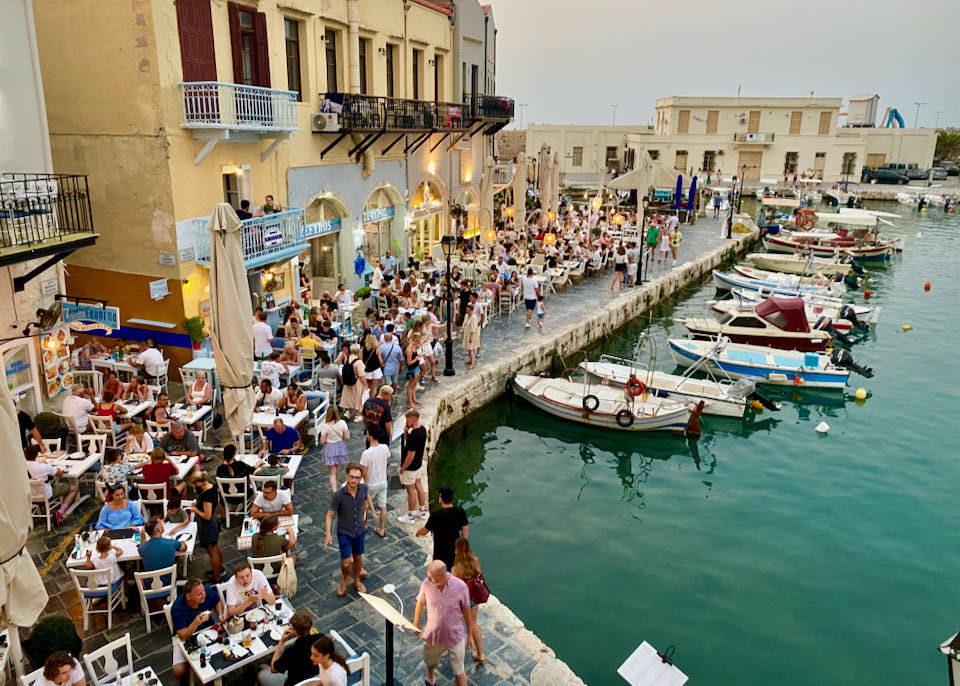
Rethymno’s picturesque Venetian harbor is lined with waterfront cafes and tavernas.
Is Crete good for families? Couples? Solo travelers?
It is one of the few islands that is truly perfect for everyone because of its size and diversity.
- For Families: Excellent. The Cretan culture is incredibly kid-friendly. The calm, shallow waters of Elafonisi and the many organized resorts with pools (especially in the Chania and Agios Nikolaos areas) make it easy. There are also water parks (Watercity) and the Cretaquarium for days off the beach.
- For Couples: Fantastic. Chania Old Town is undeniably romantic with its harbor dining. For privacy, the south coast villages (like Loutro) or the adults-only luxury resorts in Elounda offer seclusion.
- For Solo Travelers: Very Good. It is safe and lively. Staying in the main towns (Chania/Heraklion/Rethymno) ensures you are around people, have plenty of things to do, and have easy access to public transport if you don’t want to drive alone.
Where should I stay in Crete? (Best Areas for First-Timers)
Crete is massive, so choosing the right base is critical. Do not try to stay in one place and see the whole island; you will spend hours in the car. For a first trip, pick one of these four main hubs.
1. Chania (The Most Beautiful & Romantic)
If you want the classic “Greek postcard” experience, stay here. Chania has a stunning 14th-century Venetian harbor, a lighthouse, and a maze of car-free alleyways filled with bougainvillea. It is the best base for visiting the famous beaches of Elafonisi and Balos.2. Rethymno (The Best All-Rounder)
Located between Chania and Heraklion, Rethymno offers a similar “Old Town” charm to Chania but is slightly more laid-back. Its superpower? It has a huge sandy beach right in the town center. If you want history, dining, and a beach without driving, stay here.3. Heraklio (History & Transit Hub)
The capital city. It is gritty, busy, and real. It is not “pretty” like Chania, but it has incredible energy, the best museums, and is minutes from the Palace of Knossos. Stay here for 1-2 nights for history, or if you are arriving late by ferry/plane.4. Elounda & Agios Nikolaos (Luxury & Views)
In East Crete, the vibe shifts. Elounda is the most exclusive enclave in Greece, home to VIP resorts and private peninsulas. Agios Nikolaos is a chic, vibrant town built around a lake.My Verdict:
For a first-time visitor, Chania is the clear winner. It offers the perfect mix of atmosphere, dining, and access to the island’s best beaches.
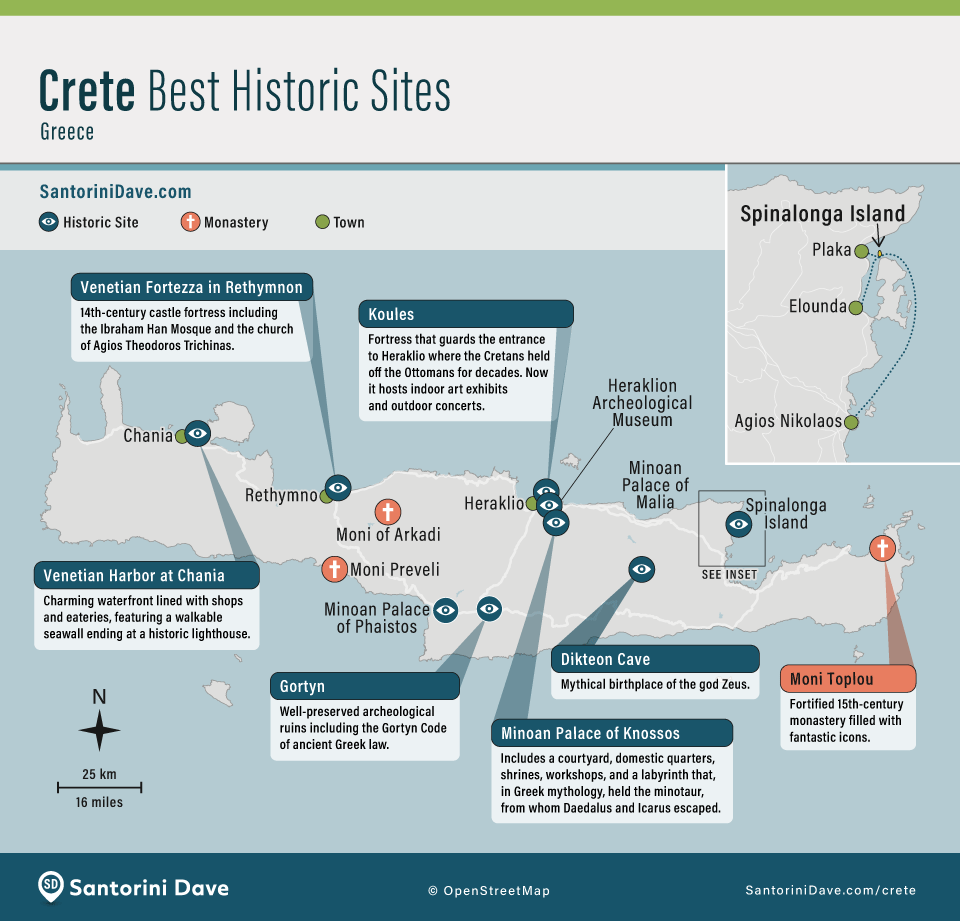
A Brief History of Crete (And Where to See It)
Crete’s history is unique from the rest of Greece. Positioned as a stepping stone between Europe, Africa, and Asia, it has been invaded, bought, and traded for millennia. Yet, the Cretan identity remains proud and fiercely independent.
Here is the timeline of the island and where you can see that history today.
1. The Minoan Era: Europe’s First Civilization (c. 2700–1450 BC)
Long before the Parthenon was built in Athens, the Minoans were building multi-story palaces with flushing toilets and complex drainage systems in Crete. They were a maritime superpower that traded with Egypt and the Near East.
- The Myth vs. Reality: In Greek mythology, this was the land of King Minos and the Minotaur (half-bull, half-man) hidden in the Labyrinth. Archeologists believe the “Labyrinth” was actually the Palace of Knossos itself – a complex maze of 1,300 rooms that would have terrified primitive visitors.
- The Collapse: The civilization ended abruptly around 1600 BC. The leading theory is that the massive volcanic eruption on nearby Santorini (Thera) caused tsunamis and ash fall that crippled the Minoan fleet and agriculture, leaving them vulnerable to invasion by the Mycenaeans from the mainland a few centuries later.
- Where to see it: The Palace of Knossos (the grand capital) and the Palace of Phaistos (the authentic, less reconstructed southern palace). The Heraklion Archaeological Museum houses the original frescoes and the mysterious Phaistos Disc.
2. Romans, Byzantines, and Arabs (69 BC – 1204 AD)
After the decline of the Greek city-states, Rome conquered Crete. It became a wealthy province, and Gortyn became the capital of Roman Crete and Cyrenaica (North Africa).
- The Arrival of Christianity: St. Paul the Apostle landed on the south coast (Kali Limenes) around 59 AD and tasked his disciple Titus with spreading Christianity. St. Titus remains the patron saint of the island.
- The Arab Emirate: In the 820s, exiles from Andalusia (Spain) conquered Crete and turned it into an Emirate for nearly 150 years. They turned the capital, Heraklion, into a fortress surrounded by a deep moat (Chandax), which became a base for pirates terrorizing the Aegean. The Byzantines eventually retook the island in 961 AD.
- Where to see it: The vast ruins of Gortyn (including the Law Code inscribed in stone) and the Church of St. Titus in Heraklion.
3. The Venetian Era: The Aesthetic (1204–1669)
After the Fourth Crusade, Crete was sold to the Republic of Venice. This 450-year period defined the look of modern Crete. The Venetians built the harbors, the lighthouses, and the massive fortifications to protect their valuable colony from the Ottomans.
- The Cretan Renaissance: Despite the oppression of the locals, art flourished. This era produced El Greco (Doménikos Theotokópoulos), the famous painter who trained in Heraklion before moving to Italy and Spain.
- The Siege of Candia: The Venetians held onto Crete long after the rest of Greece fell to the Turks. The siege of Candia (Heraklion) by the Ottomans lasted for 21 years (1648–1669) – the second-longest siege in history.
- Where to see it: The Old Harbor of Chania (the most beautiful Venetian city in Greece), the Fortezza in Rethymno, and the Koules Fortress in Heraklion.
4. Ottoman Rule & The Great Revolutions (1669–1898)
Life under the Ottoman Turks was harsh, marked by constant uprisings. The Cretans retreated to the impenetrable mountains (Sfakia and Lasithi) to launch guerilla wars.
- The Arkadi Tragedy (1866): The defining moment of Cretan resistance. During a rebellion, hundreds of women and children took refuge in the Arkadi Monastery. When the Ottoman troops breached the gates, the Cretans chose to blow up the gunpowder magazine, killing themselves and the attackers rather than surrender. It sparked global sympathy for the Cretan cause.
- Where to see it: The Arkadi Monastery (near Rethymno) remains the national shrine of the island. You can also see Ottoman mosques in Chania (the one with the pink dome) and Rethymno (the Neratze Mosque).
5. Union with Greece & The Battle of Crete (1898–1945)
Crete finally united with Greece in 1913. However, its toughest test came during WWII.
- The Battle of Crete (1941): In the first-ever large-scale airborne invasion, Nazi paratroopers dropped onto the island. They expected a quick victory but were met by fierce resistance from the Cretan civilians armed with pitchforks, old rifles, and knives. It was the first time in the war that a civilian population en masse resisted an invasion.
- The Cost: The Germans eventually took the island but suffered such heavy losses that Hitler forbade future airborne operations. The subsequent occupation was brutal, with many villages burned in reprisal for the resistance.
- Where to see it: The German War Cemetery at Maleme (overlooking the airfield) and the Allied War Cemetery at Souda Bay.
6. Modern Crete (1960s–Present)
Today, Crete is a powerhouse of the Greek economy, unique because it does not rely solely on tourism. It is an agricultural giant (producing huge amounts of olive oil, wine, and vegetables for export) and a center for education and research.
- Interesting Insight: The Cretan Diet (based on olive oil, greens, and simplicity) was studied in the 1960s (The Seven Countries Study) and found to be the exceptionally healthy, launching the global concept of the “Mediterranean Diet.”
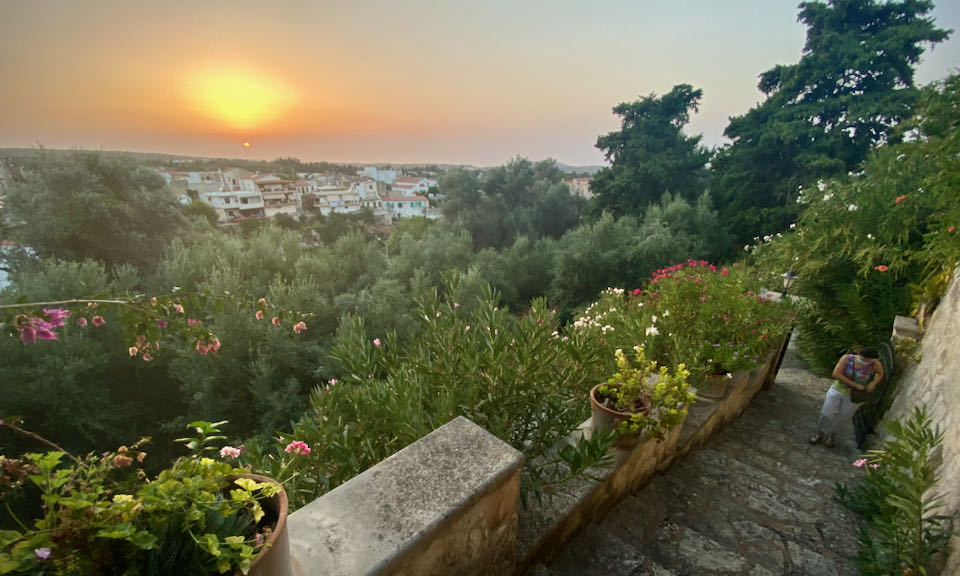
Sunset view from Margarites, one of Crete’s most beautiful traditional villages.
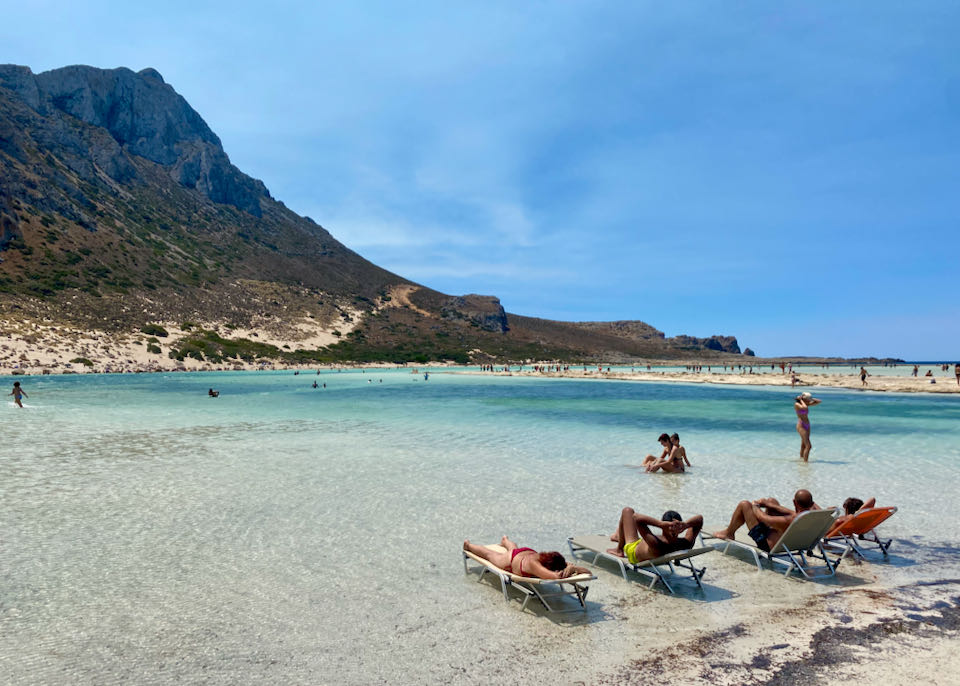
Pristine and lagoon-like, Balos Beach is best accessed via boat from Kissamos.
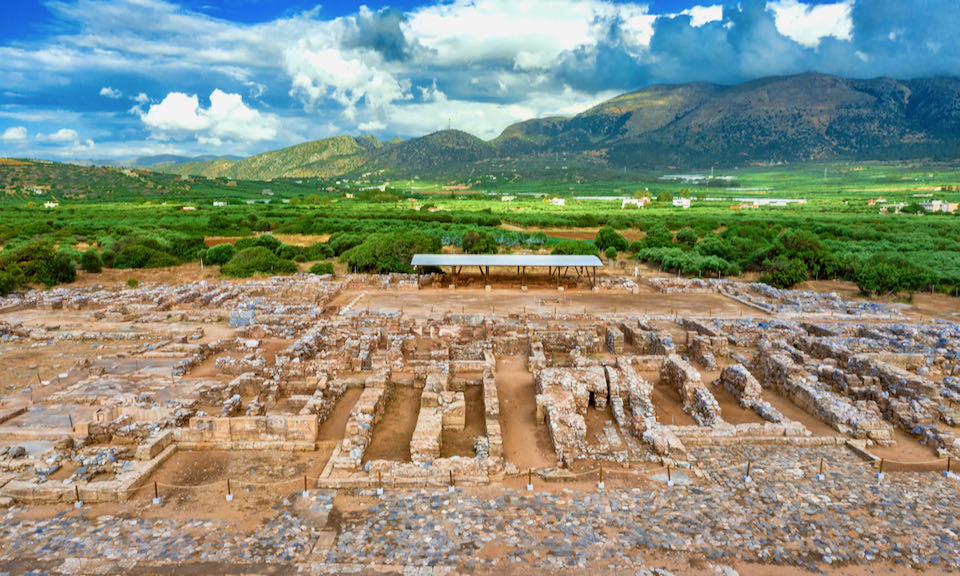
The Minoan Palace of Malia. Excavations are ongoing under the covered area in the back, where it’s possible to see archaeologists at work.
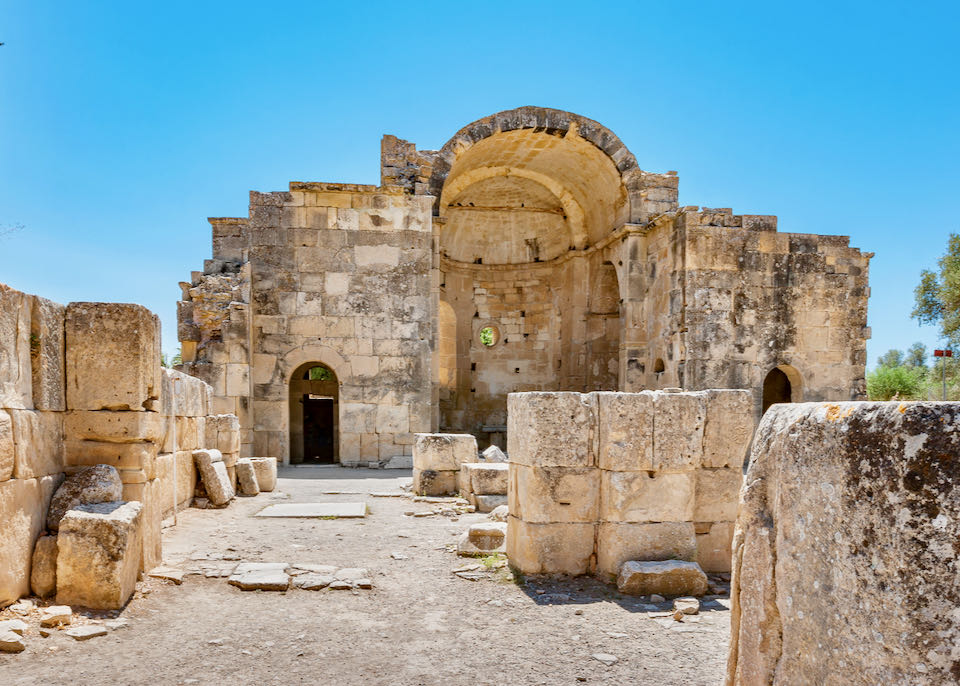
Basilica of Agios Titos in the ancient site of Gortyn.
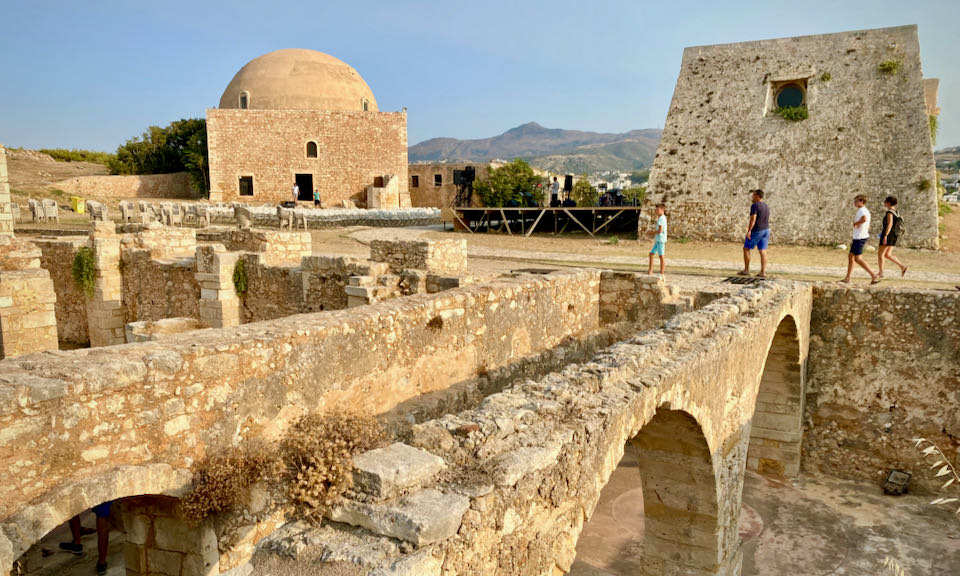
Exploring the Venetian Fortezza in Rethymno.
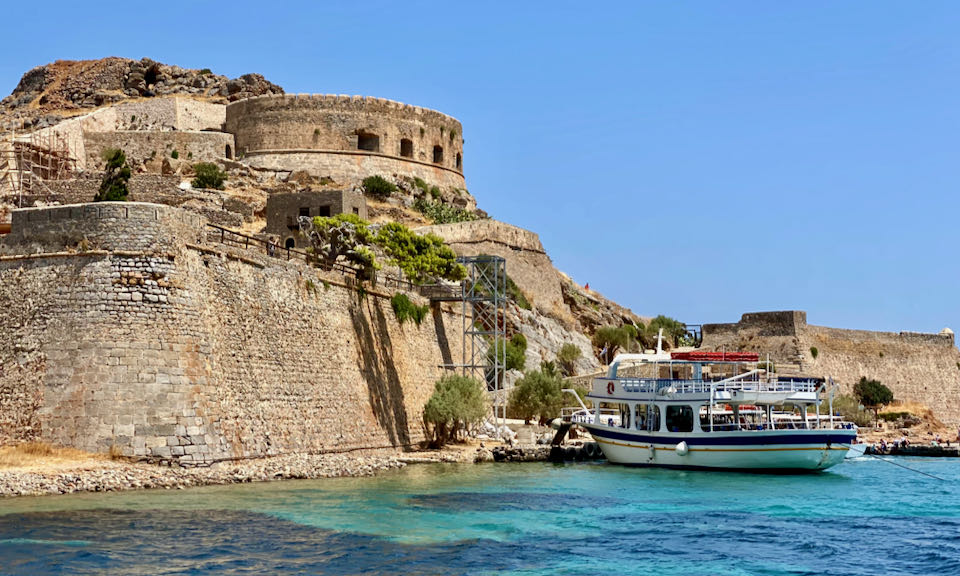
Tours to Spinalonga Island, one of Crete’s top historical attractions, depart from the towns of Agios Nikolaos, Elounda, and Plaka.
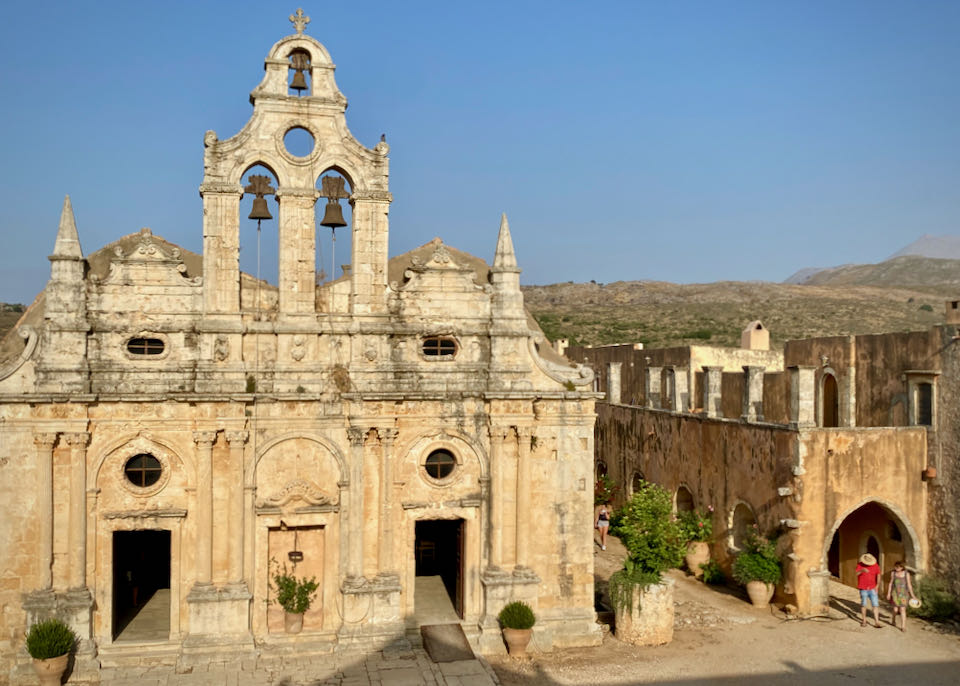
Arkadi Monastery.
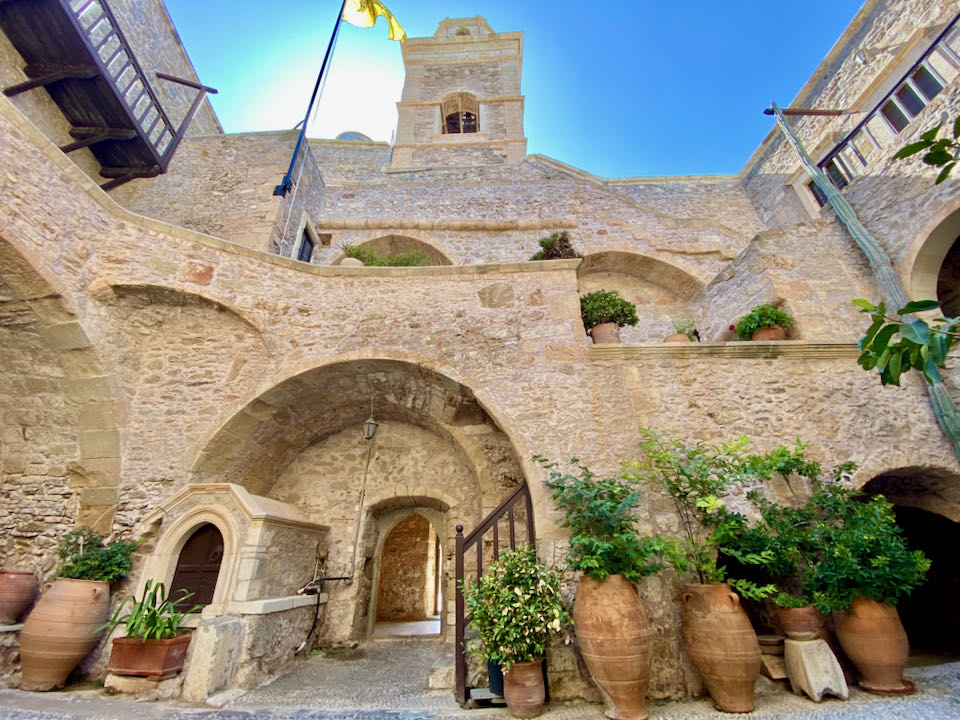
Historic Toplou Monastery on the eastern tip of Crete. The best times for sightseeing in Crete are the spring and fall.
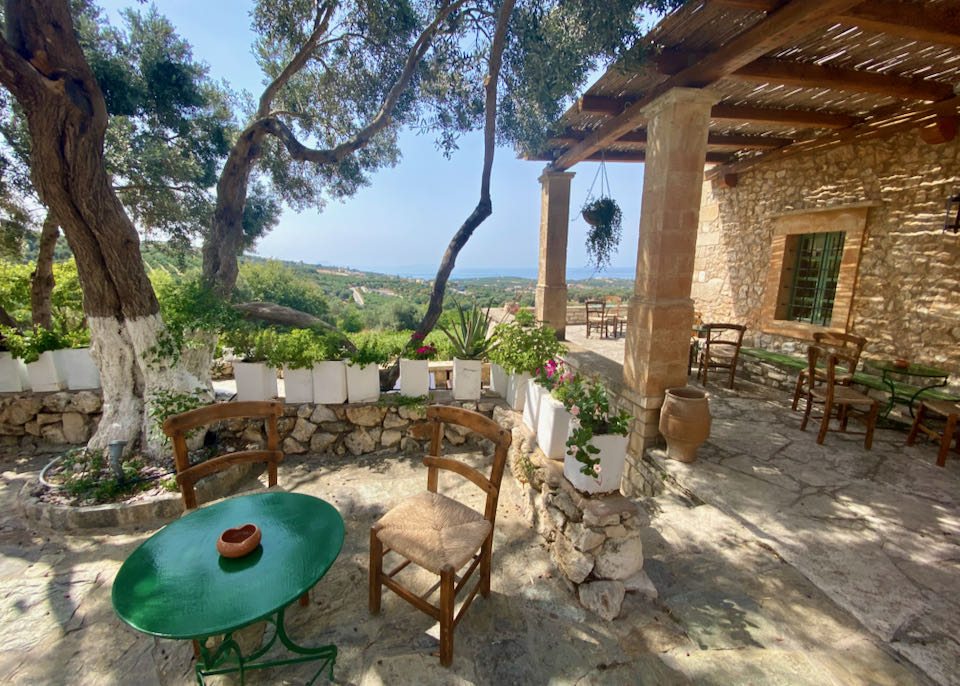
The gorgeous taverna terrace at Agreco Farm outside of Rethymno, which also offers farm tours and unique farm experiences.
About Santorini Dave